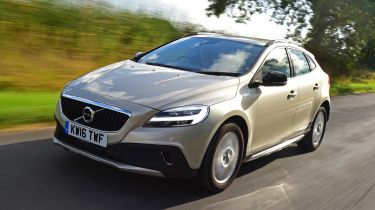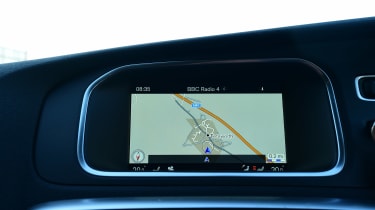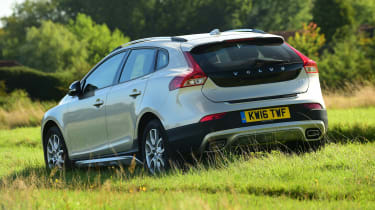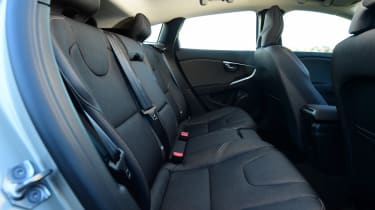Volvo V40 Cross Country (2013-2019) review
The Volvo V40 Cross Country adds rugged styling and a raised ride height to the small hatchback

The Volvo V40 Cross Country follows in the footsteps of a number of other Volvo models by adding off road-style bodywork additions to the standard V40. This tradition began with the V70 XC that arrived in 1997, and in the following 20 years there have been high-riding versions of the V70, V60 and S60, and more recently the V90 has been given the same treatment.
On the V40 Cross country, the addition of plastic body cladding and a raised ride height are largely cosmetic, because the only 4WD model in the range is the top-spec version. In reality, the Cross Country should be considered as an upmarket variant of the standard V40, especially as there is no dedicated hot hatch version on offer.
The V40 Cross Country first arrived in 2013, a year after the standard V40 hatch, while both cars were facelifted in 2016 to incorporate Volvo's latest design signature, 'Thor's Hammer' daytime running lights and introduced a revised engine range.
While the V40 Cross Country looks different to the standard hatch, thanks to its raised ride height, roof rails and extra plastic body cladding, in reality it's just a high-spec version of the V40 that fills a gap where a hot hatch variant could possibly be the flagship of the range. It's available with T3 and T5 petrol engines, as well as D2, D3 and D4 diesels, though, so is more like a trim level, though.
Used - available now

2023 Ford
Kuga
47,524 milesAutomaticPetrol2.5L
Cash £19,300
2020 Land Rover
Range Rover Velar
63,000 milesAutomaticDiesel3.0L
Cash £25,995
2020 BMW
X3
48,000 milesAutomaticDiesel2.0L
Cash £23,995
2020 BMW
X3
40,700 milesAutomaticDiesel3.0L
Cash £33,995Cross Country spec is well equipped, even if you go for the smallest engine option. Standard kit includes Bluetooth, a DAB radio, LED headlights and a multifunction steering wheel, while Volvo's full suite of safety systems is included. This includes City Safety low-speed collision prevention, a driver's knee airbag, SIPS side impact protection and anti-whiplash front seats. Nav Plus models add sat-nav, TFT dials and a comprehensive trip computer and infotainment system, while Cross Country Pro versions also include leather, an upgraded sound system and a forward folding front passenger seat.
The most recent model update has seen the V40 gain 2.0-litre engines across the board, except for the T3, which gets a 1.5-litre engine if you add the Geartronic auto gearbox. That engine has 152bhp, while the diesels start at 120bhp for the D2, 150bhp for the D3 and 190bhp for the D4. All models get a six-speed manual gearbox as standard, while the T3, D2 and D3 get an optional six-speed auto, and the D4 has an eight-speed auto option.
At the top of the range, the T5 has ditched the ageing five-cylinder turbo petrol in favour of a 2.0-litre turbo four with 245bhp. This comes with the eight-speed auto as standard and is the only Cross Country model to come with four-wheel drive.
Prices for the V40 Cross Country range from around £24,000-£35,000, which puts it in competition with some accomplished rivals. If you want a high-riding hatchback, then the closest rivals to the Volvo are the Mercedes GLA, which is essentially a raised A-Class, and the Infiniti QX30, which is Mercedes-based, but the range isn't as extensive.
Of course, you could save a bit of cash and go for the standard V40, although the shorter suspension means it won't be as comfortable. Then there are its compact executive hatch rivals, like the Audi A3, BMW 1 Series or even the Lexus CT 200h. If you want something that's a bit more practical and off-roader in style, then the Audi Q2, Mazda CX-3, MINI Countryman or Toyota C-HR could be worth considering.
The Volvo V40 Cross Country looks the part, but as it offers barely any extra off-road ability over the standard V40, and comes at a premium, it's hard to recommend. There's nothing massively wrong with the car - it's efficient, refined and classy - but it's not up to standard with rivals like the VW Golf and BMW 1 Series, while the Cross Country is no crossover in a class that has a number of hugely talented rivals at a similar price. Think of it as it's own little niche, and it makes more sense, although the price and running costs still count against it.
• Volvo V40 Cross Country D2 2016 review
Engines, performance and drive
We’re fans of the V40’s excellent refinement and assured handling already, and from behind the wheel the V40 Cross Country feels much the same. The extra 40mm of suspension height makes a small difference, helping the car to float over small imperfections and round off bigger jolts.
The extra height will help the V40 tackle an overgrown country lane, but by no means make it an off-roader. In fact, only one model, the T5 range-topper gets four-wheel drive, but that’s likely to sell in small numbers in the UK. It does prompt the question 'why does the V40 Cross Country even exist?' - but the answer to that is that some people like the styling, or the image that comes with it, rather than needing off-road ability.
The Volvo’s straight-line speed is adequate rather than impressive in D2 guise, but it is nicely refined, with not much diesel rattle coming from under the bonnet unless you rev it hard. The ride mirrors this trait; thanks to the Cross Country’s slightly raised ride height and longer suspension travel, compared with the standard V40, it soaks up rough surfaces well.
Its weighty steering and gearchange give a reassuring feeling of solidity, too, but the steering isn’t as direct as either the MINI Countryman or Audi Q2’s set-ups, and this makes the V40 feel more lethargic during direction changes.
Engines
The strongest weapon in the V40’s arsenal is its engine. This D2 2.0-litre turbodiesel delivers 118bhp, but it’s significantly more efficient than rivals like the MINI Countryman and Audi Q2. With 280Nm of torque, it’s 50Nm down on the MINI, but 30Nm up on the Q2, and this showed when we tested this trio. The Cross Country couldn’t match the Audi’s 10.1-second 0-62mph time, taking three tenths longer, but its extra torque gives more flexibility. This showed between 50-70mph in fifth and sixth, where the V40 was seven tenths and 2.1 seconds faster respectively.
MPG, CO2 and Running Costs
Volvo has a broad range of engines to choose from and has worked hard to squeeze as much fuel economy from each as possible. It’s the diesels that make most sense in the Cross Country though, delivering excellent mid-range acceleration and rock bottom fuel consumption. Most economical is the 113bhp 1.6-litre D2, which delivers 76.3mpg and 99g/km of CO2. However, the standard V40 with the same D2 engine returns 83.1mpg and 94g/km of CO2 – that’s quite significant when you consider that the Cross Country commands a premium of about £1,800.
The D4, which packs a big punch and 0-62mph time of 8.6 seconds still returns 64.2mpg and 117g/km of CO2. If you like the looks, the Cross Country package represents good value, although the standard car is still quite expensive to buy – it will depreciate faster than the BMW 1 Series, Audi A3 and Mercedes A-Class, too.
While the Volvo’s low CO2 emissions give company car users an advantage, if you’re a private buyer, our experts predict the V40 Cross Country will lose the most money when compared to an Audi Q2 or MINI Countryman.
Expected residual values of 37.3 per cent will see the Volvo shed a whopping £15,558 in this period, compared with £12,674 for the MINI, and just £11,246 for the Audi, which has impressively strong expected residuals of 54.1 per cent.
Its appealingly low claimed fuel economy didn’t translate into the best on test, either, because the V40 only managed 44.1mpg, compared with 37.7mpg for the Countryman and 51.4mpg for the Q2.
Interior, design and technology
Considering the minimal mechanical changes, the Cross Country is essentially all about style. Fortunately, Volvo has integrated the additional bodywork into the design well.
Silver roof rails are added, which give the impression of extra height, while a chunky black plastic front bumper has LED daytime running lights built in. Metal side sills, the raised ride height, a new rear bumper and metal skid plates at the front and back all add to the tougher image.
As well as the front and side scuff plates and rugged-looking bumpers, Volvo has added a handful of extra standard kit including roof rails, 16-inch alloy wheels and LED headlights as well as DAB radio and auto city braking.
Ergonomically, it’s not the best, but you still get an interesting, individual design, with a floating centre console that houses the still rather confusing, button-heavy layout for the climate controls and multimedia system. Sat-nav is standard on Nav Plus models, as are cruise control, Bluetooth, LED lights and parking sensors.
Sat-nav, stereo and infotainment
On Nav Plus and Pro versions of the V40 Cross Country, Volvo’s Sensus Navigation system is fitted as standard, while it’s about £850 to upgrade from the standard model with the Nav Plus pack.
Doing this adds a seven-inch colour display, voice control and connected services that allow you to save points of interest to the nav system from the Internet using your mobile data connection. You can also find parking locations or set a destination using your smartphone, although this is about the extent of the system’s connectivity capability.
While it’s enhanced by the Active TFT display that sits in place of the standard dials (a £300 extra), giving a more hi-tech feel with three different themes to choose from, the infotainment system’s menu layout isn’t the most logical. On top of that, the complicated centre console could do with a simplified, more user-friendly control interface such as the scroll wheels you'll find in a MINI or Audi.
Practicality, comfort and boot space
There are more spacious cars in the V40’s class, but it’s an acceptable price to pay for the eye-catching design. The Cross Country adds an extra layer of practicality, with its improved ground clearance, but inside it’s identical to the standard car. That means rear headroom is a little tight, and there’s a 335-litre boot out back – 15 litres down on the VW Golf.
It’s a relatively narrow space too, with a small opening, but a false floor that creates a tiered storage system goes someway towards making up for that. All the seats are supportive and comfortable, although there’s a lack of large cubby holes and storage pockets on the inside.
Overall though, assuming your passengers aren’t giants, it’s a comfortable car to cover big distances in, with space for a modest amount of luggage.
Reliability and Safety
Along with its high score for seat comfort, Volvo also recorded a good result for build quality in Driver Power 2016. However, mid-table finishes elsewhere saw it net a standard 13th place overall, although this was still a long way ahead of MINI and Audi.
Safety is another area where Volvo has traditionally been top of the class, and the V40 is no different. It launched in 2012 with a world-first pedestrian airbag that inflates around the base of the windscreen and its pillars for a softer landing.
Go for Volvo’s Intellisafe Pro option (about £1,900), and hopefully you won’t need the airbag, because pedestrian and cyclist detection is included, along with upgraded Full Auto Brake to complement the standard autonomous braking.
This pack also adds lane keep and blind spot assist with cross traffic alert and adaptive cruise. The V40 gets a full five-star Euro NCAP rating in 2012.












